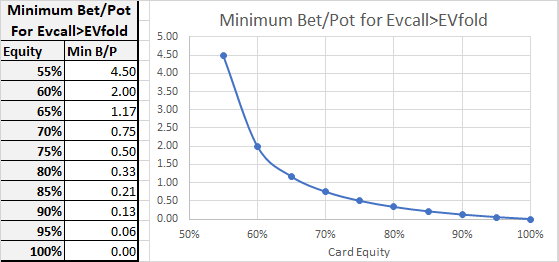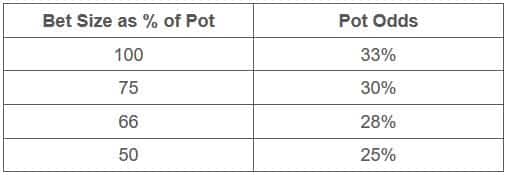Pot Equity Vs Pot Odds



Pot Equity Vs Pot Odds

Pot Equity Vs Pot Odds Calculator
Pot Equity |
© 2006 Randy Saylor |
| Advancing in poker requires analysis. There is a tool that will take your task of analyzing the game to new heights. This is the concept of pot equity. A thorough understanding of pot equity will expand your horizons. All but the greenest of poker players understands the simpler concept of pot odds. The basic poker strategies we have been taught advise us to play tight pre-flop, count outs and determine pot odds, and bet and raise with strong made hands, right? Sure, and playing that way at a full ring table in low-limit weak/tight Holdem games makes money for one party only…the poker room collecting the rake. Pot equity differs from pot odds in the sense that pot equity usually helps determine when you should bet while pot odds lets you decide whether to call. Pot Odds Pot equity’s counterpart, pot odds, is easier to understand. The simplest form of pot odds is expressed pot odds: Q: You are holding AJ in a heads-up pot, in a $5/10 limit Holdem game. On the turn, the board is K T 4 2. There was $35 in the pot. Your opponent now bets into you, and it is $10 to call. Do you have sufficient pot odds to call? A: Even assuming the worst case (that your opponent has a pair with an ace kicker, making your outs to the A no good), you have 9 outs to the flush and 3 outs to the Broadway straight (don’t count the Q twice). You know 6 cards, and there are 46 unknown cards. Your odds to win are 46/12 = 3.83 to 1, so you can call the bet. The pot is offering (expressing) $45 to $10, or 4.5-1 odds. If doing all this math hurts, calculatempro.com can do these calculations for you. The Next Step: Pot Equity Understanding the pot equity in various situations allows you to profit by betting or raising in situations where you have a distinct advantage in the hand, or can gain that advantage by not allowing other players to continue. A prime example of pot equity making your poker more profitable is when you have a large number of outs in a drawing situation. Let’s set up a situation where you have the worst hand on the flop best the highest pot equity. You are holding Q J in the big blind. An early player raises, a middle player re-raises, and you (questionably) call, only to have it capped behind you. Three players see the flop of J T 9. You bet, and it’s a raise and a 3-bet to you. Before you act, both opponents drop their cards on the table, exposing A A and K K. You’re behind to two overpairs. What is your move? Answer: Cap it! Experienced players are nodding, and newbies are shocked. Here’s the scoop: with 9 known cards, take the remaining 43 cards and deal out the turn and river in every possible way. There are (43*42)/2=903 possible outcomes. You will win 55% of those 903 deals! The AA hand will win 35%, and the KK hand will win 10%. This is because you have flush draws, straight draws, 2 jacks, and running queens as outs. Applying the known equities to the flop raise above relates the math behind the raise. If I tell you your equity is 55%, you can look at your options after the flop 3-bet. The pot (now) is 9.25BB, or $18.50 in a $1/2 game. Your 55% equity translates to $10.18, or about 5BB. It’s $2 if you call, and $3 to raise. Here is the key: When using pot equity to analyze an action, if your current equity is greater than or equal to the actual current cost of that action, you can correctly take that action. Notice that I take no consideration of the $5 you had previously invested in the pot. That money is no longer yours; it’s the pot’s. The only choice now is to fold ($0), call the 3-bet ($2), or cap it ($3). Also, the idea of cold calling the 3-bet in order to disguise your hand (knowing that the AA player will likely cap it) is a good one, but not considered here. No Limit Pot Equity While pot equity can be used to dissect LHE hands, it is more of a factor in big-bet games (pot limit or no limit), and can even be used to make quick in-game decisions. Consider the following situation: you are heads-up against a player who is near all-in before the flop, with 900 total in the pot. The flop comes with three spades, perhaps T32. He goes all in for 300 more. It’s 300 to you with 1200 in the pot. You are holding TT, so you flopped top set, but the board is suited, so you may be behind to a flopped flush. Should you call? Even if your opponent flopped a made flush, you are only a 65.5-34.5 underdog (about 2-1). A quick pot equity calculation tells you that you have 1200*34.5%= $414 equity in this pot, and it’s only $300 to call. The fact that your opponent is all in and you have limited risk makes this an easy call. How to Apply Pot Equity Evaluating pot equity during the course of a heated session is nearly impossible, especially if you are multi-tabling online. Memorizing some of the common situational equities (set vs. flush, overpair vs. overcards, etc.) will help you make more snap decisions, but the real value of calculating these numbers comes in post-play analysis. If you are playing online, review your hand histories, especially ones where you felt agonized over a decision. Use software such as Poker Stove to run the possibilities and further scrutinize your play. If you think about the decisions while away from the table, the decisions will come easier at the table. Future articles on pot equity will discuss folding equity, raising to increase equity, and backdoor draw equity. |

Pot odds are defined as the ratio between the size of the pot and the bet facing you. For example, if there is $4 in the pot and your opponent bets $1, you are being asked to pay one-fifth of the pot in order to have a chance of winning it. A call of $1 to win $5 represents pot odds of 5:1. Card Equity: 17% Pot Odds: 25%. As we have already found out we have 17% chance of making the straight on the next card, which means that we should only call 17% of what is in the pot. Because we are being forced to pay 25% to play on, we should fold. We would be losing money in the long run if we called. So, using pot odds we found out that we only need 16.67% equity to continue in the hand here. We have 9 outs to complete our flush draw. We can use the Rule of 4 and 2, which will allow us to closely approximate our equity at the table, in the following way. Pot odds represent the ratio between the size of the total pot and the size of the bet facing you. Keep in mind that the size of the total pot includes the bet(s) made in the current round. For example, if there is $2 in the pot and your opponent bets $1, your pot odds are 3 to 1. Pot equity is your percentage chance of winning the pot at any given point in a hand. That percentage is the amount of equity you have in the pot or how much of the pot 'belongs to you'. Here's a Texas Hold 'em example. You hold AsAh and you have a single opponent with what could be any hand.